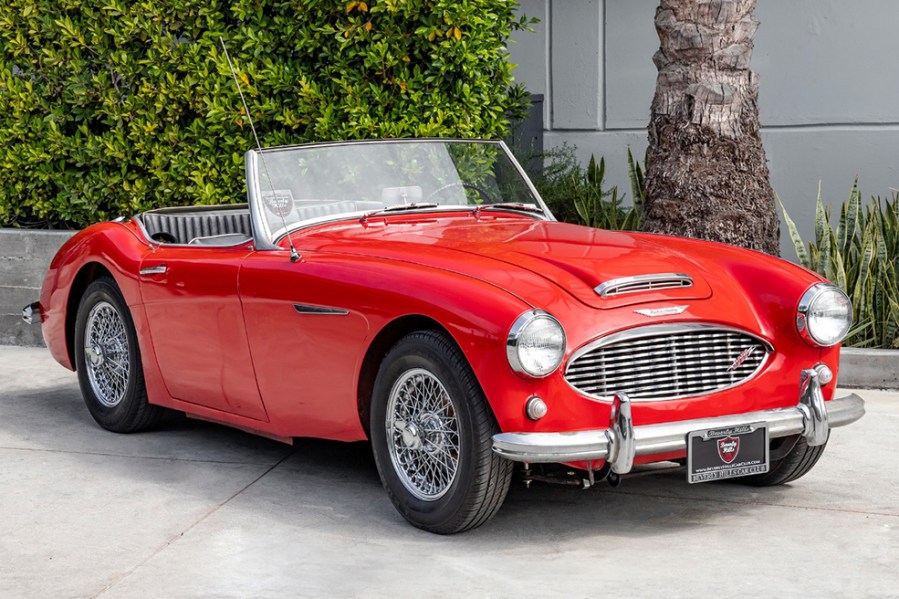The so-called ‘Big Healey’ stands as one of the most desirable classic British sports cars around. Here’s how to buy an Austin-Healey 100, 100/6 or 3000
Sponsored editorial in association with Beverly Hills Car Club
Words: Paul Wager Images: Beverly Hills Car Club
The original Big Healey is loved for the elegance of its lines but curiously was destined to remain the only complete car styled by Gerry Coker, a body engineer rather than designer. The car was born as the Healey 100 with the intention of moving the brand away from its heavy coachbuilt cars into a new, modern world as epitomised by the Jaguar XK120.
Using a BMC engine borrowed from the Austin A90, the Healey 100 was displayed at the 1952 Earls Court motor show purely as a concept, but when BMC boss Leonard Lord caught sight of it, he shook hands with Donald Healey there and then on a deal for BMC to produce the car with Austin-Healey badging.
Production of the started in 1953 as the BN1 and the car was updated into the 110bhp BN2 in 1955, then with the MGA snapping at its heels, the lightweight, 132bhp 100S.
The car we know as the Big Healey was created in 1956 when the six-cylinder C-Series engine was fitted and the car renamed 100-6 in order to lift the Austin-Healey away from direct competition with the MGA and into Jaguar’s class. Initially the 2.6-litre A90 engine was fitted and while the extra torque improved driveability, its 117bhp made it no faster than the four-pot car.
This was addressed by fitting the 3.0-litre version of the C-Series to create the Austin-Healey 3000 in 1959 which boasted 124bhp and Jaguar-style standard front disc brakes. The 3000 became the Mk2 in 1961, gaining triple SUs and revised camshaft for 130bhp, later boosted to 148bhp with the Mk3 in 1963 courtesy of bigger HD8 carbs, uprated cam and revised exhaust. Production ended in 1967.
A note on checking the originality of your potential Big Healey purchase: on all but the BN1 cars, the chassis number will be found on an aluminium plate up on the front bulkhead near the regulator. The body number is different from the chassis number and will be found on a separate plate in the same area.
Healey experts point out that it’s not unknown for the two numbers to be confused at original registration, with the body number erroneously being used as the car’s chassis number.
Bodywork
Don’t get hung up on checking panels gaps – these cars were after all, largely hand-built to 1950s standards – but uneven gaps can be a useful pointer as to either the quality of restoration work or the state of the chassis.
As a guide, use your initiative to judge whether the gaps are even on both sides of the car. The alignment of the swage line from door to rear wing can be a useful pointer here, while the bonnet and boot lids shouldn’t foul the surrounding bodywork. Experts on these cars advise that a well-adjusted door shouldn’t need a hefty slam to shut nicely.
Remember that the doors and wings are made from steel and so will rot, especially inside the bottom few inches. The ‘shrouds’ between the wings front and rear are aluminium, so won’t rust but can suffer from electrolytic corrosion where they meet the steel parts.
Most Big Healey examples will have been restored at least once by now and it really pays to look at several examples. If you have the chance to look at an unrestored example at a show, it’s an invaluable reference point.
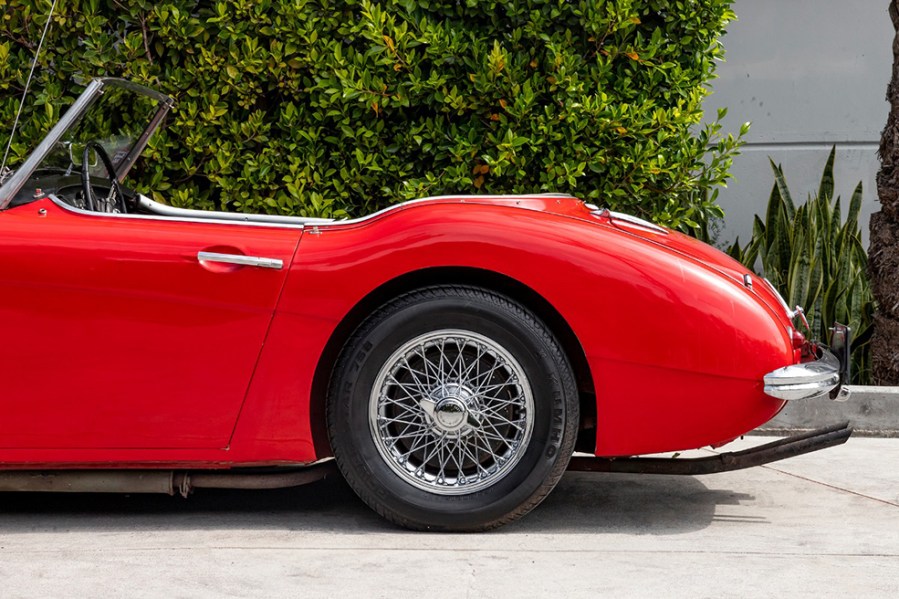
By the same token, you’ll rarely be looking at original paint, so make your own judgement as to whether it’s acceptable or not: orange peel can generally be buffed out, but a half-hearted colour change will need a complete stripdown to sort properly. On the subject of which, be aware that some BN1 cars which were originally manufactured in white were sent from the factory with a black painted engine bay.
Underneath check the outriggers running from the main frame rails out to the inside of the sills, which run under the doors – themselves another favourite rot spot. Weakened outriggers can cause a sagging body and explain erratic panel gaps around door and bonnet. Both front and rear crossmembers are often damaged by trolley jacks and sometimes this is enough to start it rusting.
Check the condition of the chrome items, as although it’s generally long lasting, replacing or replating a large number of pieces will get expensive. Early BN1 and BN2 cars used a satin-effect finish for the vertical grille bars, while other models used chrome.
The original convertible top on Big Healeys was made from synthetic Vynide and although the roof is a basic affair, it is durable and cheap to replace. Many of these cars live in the garage with the roof down though, so check its condition since long-term storage like this does the plastic window no favours.
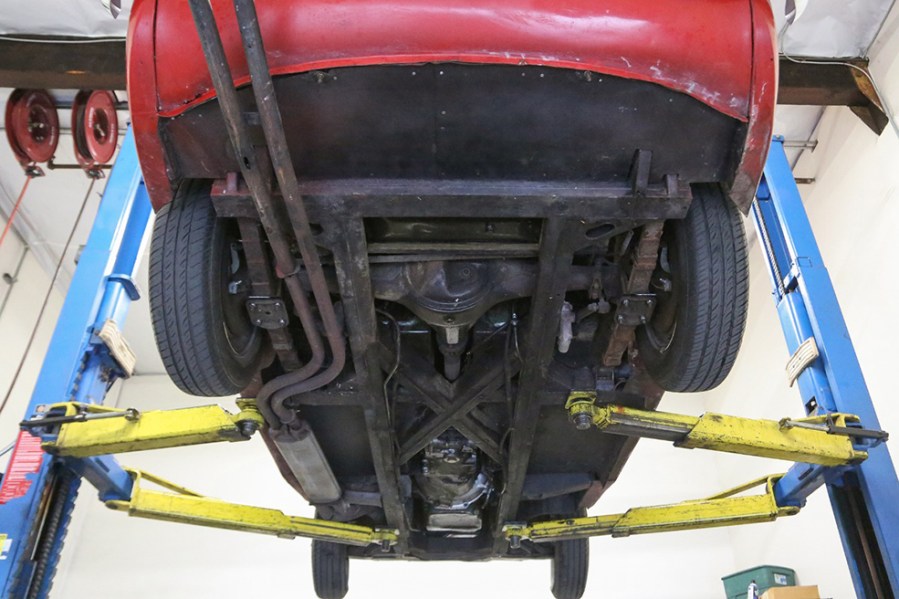
Engine and transmission
The Austin engine is a tough old beast but only if it’s properly maintained. Luckily, Big Healey values today mean most will have been serviced properly, but dip the oil just in case. Do be put off by a tatty engine bay, but don’t be put off by honest grime and few oil leaks: these engines were known for leaking, especially a seeping leak between the block and head and from the rocker cover. The core plugs can also leak coolant but you’ll need a mirror to see them since they’re hidden by the intake and carburettors.
The exhaust system on the Big Healey hangs very low, so give it a quick check for damage. Most will show signs of grounding so unless things look bent or split then don’t be alarmed.
A good engine will show 50-60psi oil pressure when warm on the move at 3000rpm, with anything under 40psi being cause for concern. At idle, 20-25psi is usual. It may not be disaster though since the gauges are often incorrect and the problem may also be simply down to the pressure relief spring.
Remember, you’ve got no synchro in first gear and Healey experts also advise against brutal acceleration to the redline in the lower two gears. The overdrive should engage and disengage with no more than a gentle bump.
Unusual clunks when accelerating or slowing can be down to worn splines on wire-wheeled cars.
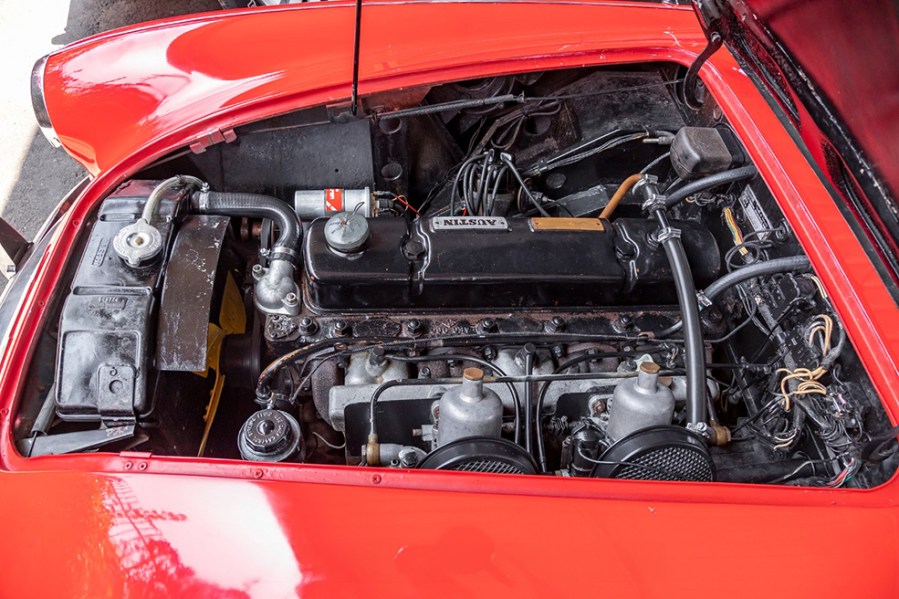
Steering, suspension and brakes
The Big Healey uses worm and peg steering rather than a rack, so you can expect some play in the system: 1-2cm at the wheel rim is considered acceptable and the steering should generally feel tight.
These cars do sit low, but tired springs can make them look even lower, so check that it sits correctly with the wheel in the centre of the bodywork opening. On the later Mk3 cars, the raised ride height makes the wheel appear lower in the wing opening.
You’re looking at drums all round as standard kit until March 1959, with an optional servo from 1961, made standard from late 1963. The drums really are hard work in modern traffic so don’t be surprised to find front discs or a servo retrofitted to cars originally supplied without.
Interior and trim
A shabby interior on a Healey won’t plunge you into the expense of restoring something like a Jaguar interior, but it should be presentable nonetheless. Prior to the BJ8 in 1963, leather seats were standard with Ambla vinyl after this point and leather an option. Pre-’53 cars had fixed seats and an adjustable column, with adjustable driver’s seat added from December 1953 when the adjustable column was deleted. From the BN4 series cars, both seats could be adjusted.
On the test drive, don’t be alarmed by a speedometer needle which waves noticeably as it’s a common issue; oiling or replacing the cable may cure it. Similarly, the fuel gauge will vary with the movement of the car. It can be improved with attention to the earth but not eliminated entirely.
If you’re a taller driver, don’t be put off if a generously stuffed seat cushion makes it tricky to slide under the steering wheel. The seats are often over-filled by trimmers wanting them to look luxurious and it can easily be sorted to lower the driving position usefully.
If the car seems unduly hot inside on a test drive, check for heat shields above the exhaust. The floors of the rally cars got so hot that they famously melted the drivers’ shoes, so they’re worth having.

‘Big Healey’: our verdict
Big Healeys aren’t cheap cars to buy – budget on £20,000 for a project, £30,000 upwards for presentable cars and around £50,000 upwards for the best – but once in your possession they don’t come with exotic running costs thanks to their workaday oily bits. Parts support is also tremendous with a huge following on both sides of the Atlantic meaning there’s virtually nothing you can’t obtain.
Production of the Austin-Healey 3000 ended in 1967 but remains a 1950s car at heart, which means it needs proper commitment to drive. The joy of driving a Big Healey stems not from the delicacy of its responses or the elegance of its engineering, but from the satisfaction of mastering what can be a physically demanding car to drive.
As one owner said to us recently, it’s like driving a really fast vintage bus and once you gel with the car, you know you’ve really mastered the art of driving in its most traditional sense.
You’ll also have found a new respect for the men and women who rallied the cars at international level, often with floors which got so hot from exhaust heat that they literally melted shoes.
It’s hard to imagine a more rugged and exciting British sports car than the Austin-Healey 3000.
Sponsored by Beverly Hills Car Club
The automobiles sold at Beverly Hills Car Club combine all the elements of its exclusive address in Los Angeles: cars for sale that are the very last word in tasteful elegance, chic and impressive sophistication, with careful attention given to each vehicle and each client. Both national and international customers are catered for, including those in the UK, with a huge stock of classics to choose from.
The 1960 Austin-Healey 3000 in these pictures is one of many examples for sale at Beverly Hills Car Club at time of writing, priced at $29,950.
For more information and to view the Beverly Hills Car Club stock, visit beverlyhillscarclub.com
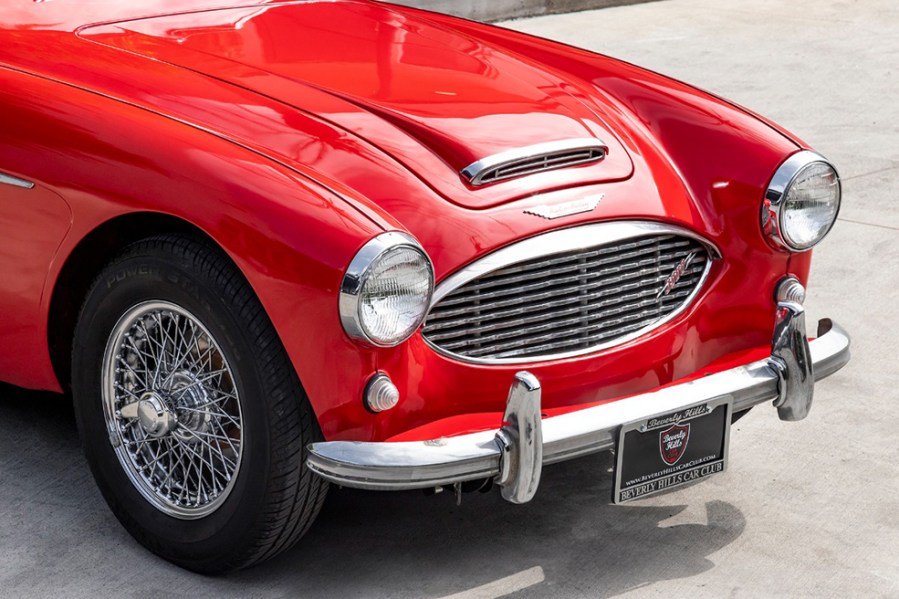
‘Big Healey’ timeline
1952
One-off Tickford-bodied Healey Hundred shown at the London Motor Show
1953
Austin-Healey 100 arrives on sale as replacement for the Austin A90
Work begins on the 100 race car project
1954
Austin-Healey 100 ‘SPL’ racer wins at Sebring, inspiring the 100S name for its successors
1955
Austin-Healey 100S production starts; just 50 are made in total
Austin-Healey 100 BN1 production ends with 10,030 made
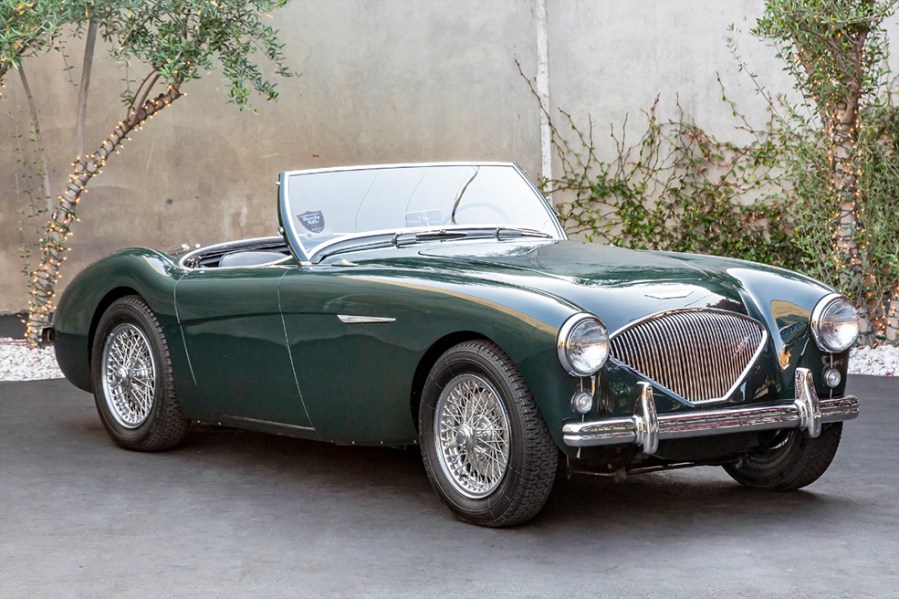
Austin-Healey 100 BN1
BN2 version introduced with four-speed manual gearbox with overdrive, a revised rear axle, larger front wheel arches and the option of two-tone paint
High-performance Austin-Healey 100M introduced with engine, suspension and bodywork upgrades
Le Mans Engine Modification Kit introduced as upgrade package for existing 100 models
1956
Austin-Healey 100 BN2 production ends with 4,604 examples made
Austin-Healey 100-6 arrives in September in 2+2 BN4 form, boasting six-cylinder power, a longer wheelbase and revised bodywork

Austin-Healey 100-6 BN4
1957
Production moves from Longbridge to MG’s factory in Abingdon
1958
Two-seater 100-6 BN6 introduced
1959
100-6 production ends
Austin-Healey 3000 introduced with 3.0-litre engine, revised styling and front disc brakes among its upgrades. Available in in two-seater and 2+2 forms codenamed BT7 and BN7 respectively
1961
3000 Mk2 arrives with various upgrades including three SU carburettors, a vertical-slat grille and an optional brake servo
1962
3000 BJ7 sports convertible adds wrap-around windscreen, quick-folding roof and wind-up windows, along with twin SU HS6 carbs
Pininfarina-designed hard-top Austin-Healey 3000 shown at the Earls Court Motorshow
1964
3000 Mk3 revisions introduced with sports convertible BJ8 model. Changes include upgraded carbs, high-lift cams, standard servoed brakes and revised dash layout
Phase 2 Mk3 update in May introduces revised rear chassis

Austin-Healey 3000 Mk3 BJ8
1966
Austin-Healey 4000 Mk4 considered, complete with 3.9-litre Rolls-Royce power. Prototypes made but production never materialises
1967
Production ends and the Big Healey is effectively replaced in the BMC lineup by the MGC

